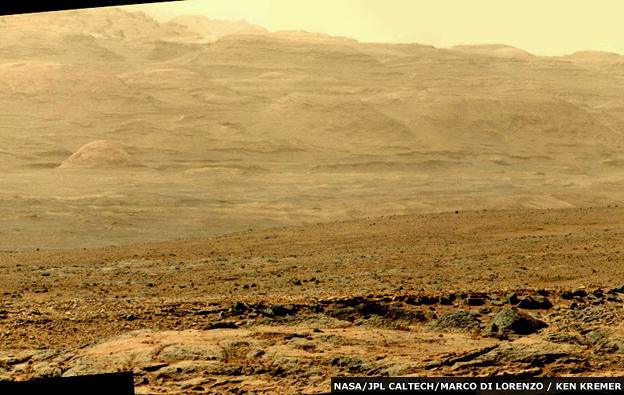Mars rover finally looks set to drill
- Published
Nasa's Curiosity rover is very close to drilling into its first Martian rock, with the set-up operation likely to begin next week.
After breaking for the holidays, the mission team would be raring to undertake the task in the coming days, said lead scientist John Grotzinger.
The robot has driven about 650m from its landing site, dropping down into a depression known as Yellowknife Bay.
It is in this depression that the target rock will probably be chosen.
All of Curiosity's instruments have been commissioned. Its rock brush and drill are the only tools that have yet to be deployed.
The drill's hammer action will enable the device to retrieve powdered samples from up to 5cm inside the rock, which can then passed to the rover's onboard laboratories for analysis.
"We are firing on all cylinders now and our last thing to do is drilling, and we really hope to start on that process beginning next week," the California Institute of Technology professor told the BBC's Science in Action programme.
As Curiosity trundled through Yellowknife Bay in December, it used its survey instruments to try to identify the most promising candidate rock. This equipment comprises the mast-mounted colour cameras and laser spectrometer, and the arm-held "hand lens" camera and X-ray spectrometer.
Yellowknife was chosen as a destination because it represents a different type of rock terrain from the one on which Curiosity landed in August and on which it has done most of its driving. Satellite observations indicate this landscape has a high thermal inertia - that is to say, at night it loses heat more slowly than the terrains that abut it in the local area.
Pictures returned to Earth from inside Yellowknife Bay appear to show copious sedimentary deposits.
"We're down at the very lowest layer - what would be the oldest layer that we would see in this succession that might be five to eight metres thick, and that is very likely where we are going to choose our first drilling target, because suddenly we've come into an area that represents a very high diversity of things we haven't seen before," said Prof Grotzinger.
In 2012, Curiosity examined the dusty soils that gave it an insight into the processes that drive the dry and cold environment that dominates Mars today. Drilling into rock this month will allow scientists to glimpse processes that held sway in ancient times, hopefully ones where water played key roles.
"The place where Curiosity is right now is a small stack of layers - very impressive - and they could be 3-3.5 billion years old, and so we're very excited about this because unlike the soil which we were analysing before the holiday season - a loose, windswept patch of dirt on the surface of Mars - we're now going to start digging down into the very ancient bedrock which we really built the rover to look at," explained Prof Grotzinger.
"We use these layers as a sort of recording device of past events and conditions, and the rover has the same kind of analytical capability that we would use here on Earth to tell us about the early environmental conditions; and, if life had ever evolved, [whether it would] be the kind of environment that would have been conducive towards sustaining that life."
The panorama of Yellowknife Bay at the top of this page was assembled by US-based scientist and journalist Ken Kremer, external and Italy-based physicist and photographer Marco Di Lorenzo. Ken and Marco are routinely stitching together the stream of images returned by Curiosity to make vistas that Nasa itself does not always find the time to produce and place in the public domain.
The top picture incorporates shots from the rover's black-and-white navigation cameras that have subsequently been coloured.
Below is a panorama looking away into the distance towards the foothills of Mount Sharp, the 5km rise that is the eventual destination of Curiosity. Once the rover has finished investigating Yellowknife Bay, it will climb back out and begin the drive to the mountain. This journey is likely to take many months.

- Published3 January 2013
- Published4 December 2012
- Published4 December 2012
- Published10 September 2012
- Published6 August 2012
- Published25 May 2012